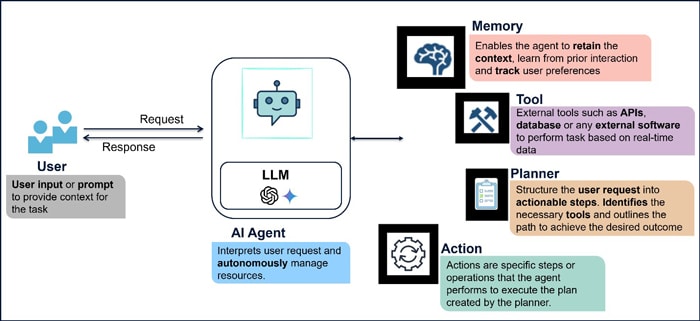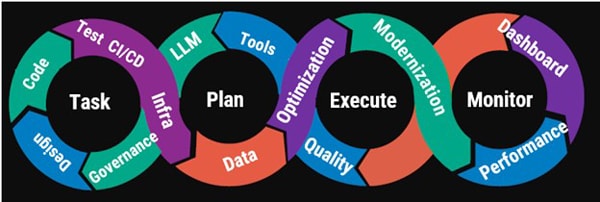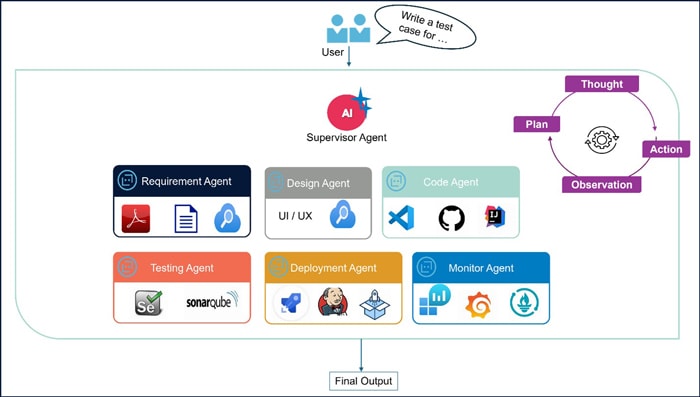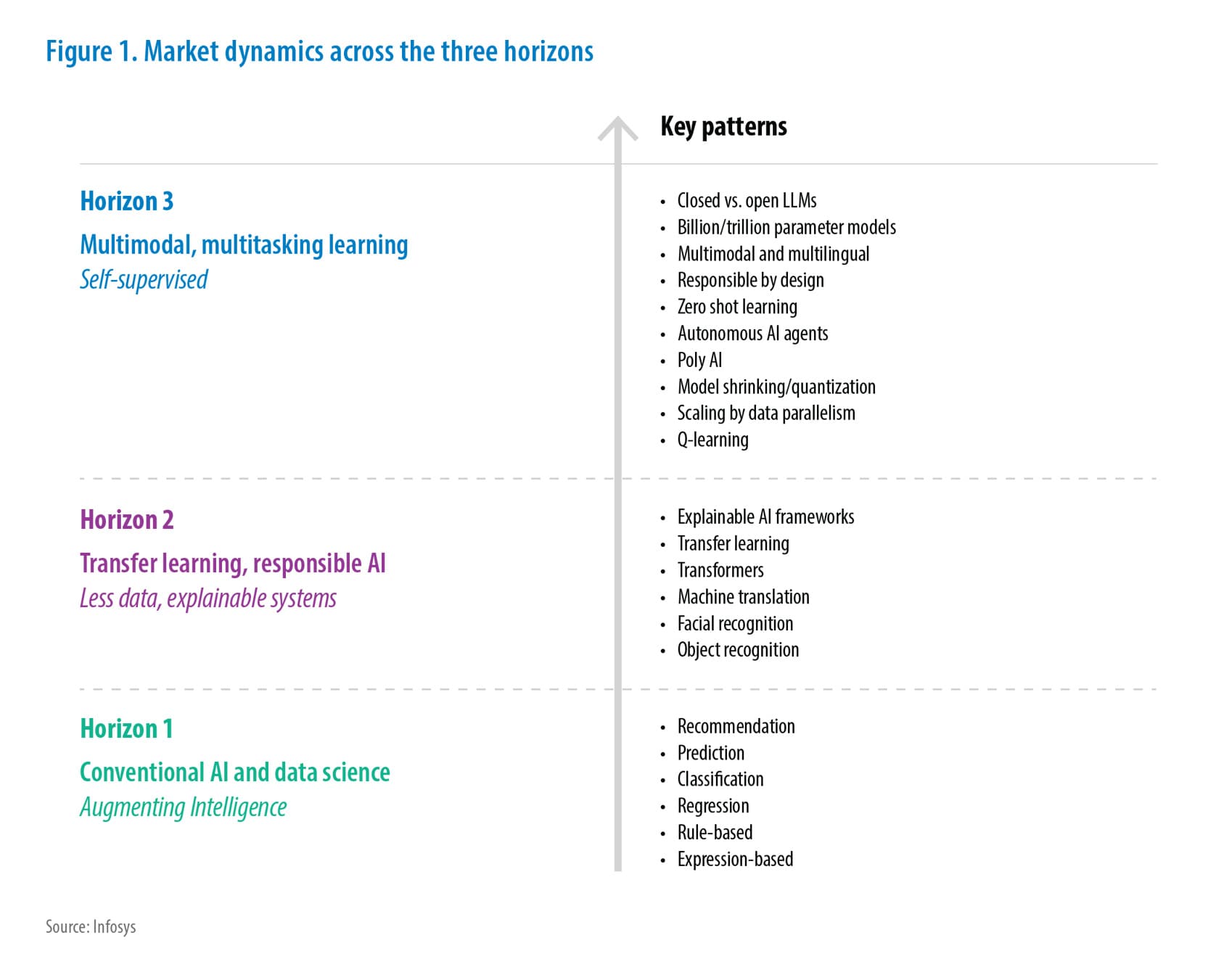Artificial Intelligence
Accelerating Software Development - Harnessing Agentic AI
This whitepaper explores the future of software development is intelligent, autonomous, and Agentic. This white paper examines the emerging field of Agentic AI and its profound implications for the entire development lifecycle. We dissect the essential components that power AI agents, their strategic integration within development workflows, and the underlying pillars that support their effectiveness. Through a comparative study of traditional and Agentic AI-enhanced methodologies, we demonstrate how organizations can unlock new levels of agility, innovation, and efficiency. Discover practical guidance on deploying Agentic AI across diverse development scenarios, from greenfield initiatives to brownfield transformations and app modernization programs.
Insights
- Agentic AI is poised to revolutionize software development. AI agents can dramatically accelerate the development lifecycle, from initial design to deployment and maintenance.
- This white paper investigates the transformative potential of Agentic AI in software development.
- Identifying key pillars that drive success, we then present a practical framework for building an Agentic AI-powered development workflow, contrasting traditional methodologies with the enhanced capabilities offered by AI agents.
- Specific use cases, including greenfield projects, brownfield environments, and application modernization initiatives, demonstrate how Agentic AI can significantly accelerate software delivery, improve quality, and reduce development costs.
Introduction
The software development landscape is undergoing a profound transformation, driven by the emergence of Agentic AI. Moving beyond the limitations of traditional, task-specific AI models, Agentic AI systems are heralding a new era of autonomous, goal-directed behavior in software creation. Unlike their conventional counterparts, Agentic AI entities proactively engage with development environments, demonstrating a capacity to adapt to dynamic conditions, autonomously make critical decisions, and purposefully strive to achieve defined objectives.
This paradigm shift marks a decisive move toward more intelligent, efficient, and adaptive software development lifecycles. Imagine AI agents collaborating seamlessly throughout the entire process – from the initial spark of an idea to the final deployment and ongoing maintenance of a software application. These agents, powered by advanced planning and reasoning capabilities, can analyze user needs, generate design options, write code, conduct rigorous testing, deploy software, and monitor performance with minimal human intervention.
Overview of Agentic AI
Agentic AI represents a paradigm shift in artificial intelligence, moving beyond traditional task-specific models towards systems capable of autonomous goal-directed behavior. Unlike conventional AI, which often excels in narrow domains, Agentic AI systems exhibit a higher degree of autonomy, enabling them to:
- Proactively Interact with Environments: Agentic AI systems are not passive observers. They actively perceive and respond to their surroundings, adapting to dynamic conditions and potentially modifying the environment itself.
- Exhibit Purposeful Behavior: Driven by specific objectives, these systems plan, execute actions, and learn from their experiences to achieve desired outcomes.
- Demonstrate Autonomous Decision-Making: Agentic AI systems possess the ability to make independent choices, selecting the most appropriate actions to pursue their goals within the constraints of their environment.
High-level Components of AI Agent
Users interact with AI Agents via requests. The agent's core, an LLM, interprets these requests. The agent then employs a Planner to structure the request, utilizing Tools, and Memory for context, to produce an Action and a response.
Figure 1: Components of AI Agent

Nexus of Agentic AI in Development Life Cycle
Agentic AI in the development lifecycle presents a transformative opportunity to create more efficient, reliable, and intelligent software.
- Offers a major advancement in software development, enabling the creation of more efficient, reliable, and intelligent applications.
- Empowers autonomous decision-making, significantly reducing the need for human intervention and driving a revolution in the development lifecycle.
- Enhances every phase of software development, from requirements gathering to maintenance, blending human expertise with AI-driven autonomy.
- The model utilizes a "Supervisor" agent that coordinates a network of specialized agents, each with unique capabilities.
- Improves requirements analysis by processing user feedback, market trends, and existing system data, surpassing traditional methods.
- Analyze extensive datasets and generate detailed user stories.
- Based on defined requirements, diverse design options are proposed, considering performance, scalability, and security, and architectures can be simulated to accelerate and optimize solutions.
- Rapidly generates functional prototypes and simulations, enabling developers to quickly visualize and test designs, leading to faster feedback loops and reduced development time.
Pillars of Agentic AI
Agentic AI systems, designed for autonomous operation, rely on a set of core functional components to achieve their objectives. These "pillars" ensure that the agent can effectively navigate its environment, make decisions, and execute tasks.
Figure 2: Pillars of Agentic AI

Task Component:
This component defines the objectives and goals the AI agent needs to achieve. It involves breaking down complex tasks into smaller, manageable subtasks. The task component ensures that the agent understands what needs to be done and sets the stage for the planning and execution phases.
Planner Component:
The planner is responsible for devising a strategy or plan to accomplish the tasks. It uses algorithms to determine the best sequence of actions to achieve the goals. The planner considers numerous factors such as resource availability, time constraints, and potential obstacles. It creates a roadmap for the agent to follow.
Executor Component:
The executor conducts the actions specified by the planner. It interacts with the environment, whether it is a physical space or a digital system, to perform the necessary tasks. The executor ensures that each action is executed correctly and in the right order. It may also need to adapt to real-time changes and unexpected events during execution.
Monitor Component:
The monitor oversees the entire process, ensuring that the agent stays on track and meets its objectives. It continuously checks the progress of the tasks and the performance of the executor. If any issues or deviations are detected, the monitor can trigger adjustments in the plan or execution. This component is crucial for maintaining the reliability and efficiency of the AI agent.
Building an Agentic AI-Powered Development Workflow
Traditional approach
The traditional Software Development Lifecycle (SDLC) involves several critical stages, including design, coding, testing, security assessments, and deployment. Classical SDLC methodologies often follow a linear or sequential model, such as the Waterfall model, where each phase must be completed before moving on to the next. This approach can result in longer development cycles and less flexibility in responding to changes.
Modern development practices, on the other hand, often use Continuous Integration and Continuous Delivery (CI/CD) methodologies. These practices enable iterative development and rapid deployment to production environments, allowing for more frequent updates and quicker response to feedback.
Contemporary development practices require developers to take on broader responsibilities beyond core coding tasks. This includes managing databases, provisioning and managing infrastructure within cloud environments, and ensuring adherence to customer-specific governance and audit requirements. These additional responsibilities can lead to a more integrated and holistic approach to development.
Current development processes often involve multiple specialized teams, each with distinct roles and responsibilities. While this specialization can enhance efficiency, it can also introduce complexities in communication and coordination. Furthermore, many aspects of the development process still rely heavily on manual intervention, hindering overall efficiency and increasing the potential for human error.
The current approach relies on a diverse team of professionals, each with specific skills and responsibilities such as Architect, Product Owner, Developer, Tester, Migration consultant, Database administrator, Business Analyst etc. Employing full team of specialist involves high cost and time-consuming.
Agentic AI Approach
The Agentic AI approach involves AI Agents either assist or take ownership in format of action throughout the software development lifecycle. Agents can be used to ideate and generate plans for activities; during design and prototyping provide UI frame template and improvements of those; generate code during development, aid in code completion, and automating mundane tasks; during the testing and debugging phase, it is the AI agents that execute tests, spot bugs, and recommend how one could fix such bugs.
The key shift here is the significant reduction in reliance on human experts. These specialized AI agents embody the knowledge and skills of these experts, automating tasks that previously required human intervention.
Finally, the AI Agents deploy the software and monitor its ongoing performance, making necessary adjustments. In such a way, gains in productivity, efficiency, flexibility, and continuous improvement are enhanced.
In Agentic AI approach, the Supervisor Agent acts as a task orchestrator, interpreting user requirements provided as 'Prompt Text' and associated 'Document Content.' This input serves as a task definition for the Supervisor Agent. Based on this task, the Supervisor Agent generates a dynamic execution plan, potentially involving sequential or parallel execution of sub-tasks. Developers have the authority to review and approve this generated plan before its execution. Subsequently, the Supervisor Agent dispatches action items from this execution plan to networked agents for execution."
Figure 3: SDLC using Agentic AI

Greenfield Implementation
AI Agents can revolutionize greenfield implementations, enabling fully autonomous creation of software systems. For example, the user can simply articulate the intended goal of the application “I need an e-commerce platform that integrates with social media and offers personalized recommendations” as a prompt to the supervisor agent. The team of AI agents autonomously handle the entire implementation process right from requirements gathering, initial design to final deployment without requiring extensive human intervention.
The Supervisor Agent: This agent acts as a central orchestrator and manages the interaction between these agents, ensuring a smooth and coordinated workflow. This agent will plan and assign the tasks to different agents. It tracks the progress of each enhancement, handles dependencies between agents, and manages communication with the user.
Each agent focusses on a particular activity and communicates with other agents. The possible agents are:
The Requirement Agent: This agent interprets the user’s natural language request, clarifies the ambiguities, and translates into a structured, machine-understandable format. A Small Language Model (SLM) can be used which will the pre-trained data specific to the organization. The real time data can be maintained in RAG data store. This agent can refer to this RAG data store and ask questions based on organization specific information to refine the requirements.
The Design Agent: This agent takes the structured requirement and generates design mockups, wireframes, considering UI/UX best practices and the existing application’s design language. It could present several options to the user for approval.
The Coding Agent: Once a design is approved, this agent generates the necessary code, leveraging Large Language Model (LLM) trained on vast code repositories. It can work across multiple programming languages and frameworks. This code generation agent can be integrated with any of the IDE through the extensions specific to the IDEs.
The Reviewer agent: This agent acts as peer reviewer, examining the generated code for potential bugs, security vulnerabilities, and adherence to coding standards. It can leverage static code analysis tools such as SonarQube, security analysis tools such as Fortify, Appscan and identify the areas for improvement. This agent works in tandem with the coding agent, providing feedback and suggesting optimizations.
The Testing agent: This agent automatically creates and executes test cases to validate the code changes, ensuring functionality and preventing regressions. It can perform unit tests, integration tests, and even user acceptance tests.
The Deployment agents: After successful testing, this agent orchestrates the deployment process, seamlessly integrating the changes into the production environment with minimal downtime. This agent can integrate with tools such as Ansible, Jenkins, Terraform etc.
It works along with the Architecture agent to ensure the environment matches the application’s needs. This agent packages the modernized application and deploys to target environment by following various strategies such as blue/green deployments, canary, rolling updates by minimizing the downtime.
In case of issues after deployment, this agent can automatically rollback to the previous version of the application to minimize the disruption to the business.
The Monitoring agents: Post deployment, this agent monitors the application for performance issues by integrating with monitoring tools such as Splunk, Prometheus, Grafana, Datadog and providing feedback to the other agents for continuous improvement.
Brownfield Implementation
In this type of implementation, the existing system is enhanced with new development rather than starting from scratch.
The agent for requirements gathering is not required always. Based on the prompts from the user, the existing documentation will be referenced by the Supervisor agent using RAG. The design agent will be called if there is any update required in the design artifacts.
Once the task is completed by the design agent, the coding agent will be triggered. It will generate the code for the new changes that are required. The quality check agents are triggered once the coding is completed. The testing agent takes care of generating the test cases and running the test cases. The defects that are found will be fed back to the Code agent to get fixed and they are retested by the testing agent. Once all the defects are fixed, the deployment agent is triggered.
Scenario 1: Enhancing the current application
Minor or major enhancements may be required in the existing application to support business needs. Enhancements can occur in various layers such as UI, backend, or middleware. With the help of Agentic AI, a non-technical user can specify the needed changes through prompts to the Supervisor agent. For example, the user can enter the prompt “Add a filter to the product catalog to sort by price range”.
The Supervisor agent will gather the required changes and ask clarifying questions if needed. Based on the requirements changes will be made to the UI layer and backend API calls. In such cases, the agent will update the wireframe if needed and sequentially call the coding and testing agents.
The deployment agent can develop a rollout plan for releasing the enhancements to users, considering factors such as user communication, application downtime etc.
Scenario 2: Performance optimization of the existing application
Users can specify the intended performance improvements such as reducing the page load time, increasing transaction throughput or improving response time. The AI agent will determine the metrics that will measure the performance and set the specific target values based on the user input.
The Development Agent will analyze the codebase for inefficient code, redundant operations and unnecessary computations. It will refactor the code to improve efficiency and reduce resource consumption. It will choose the appropriate algorithms and data structure to minimize the execution time and memory usage, fix the memory leaks and secure the application from crashes.
The Database Agent will optimize queries, use indexing, query rewriting and other techniques to speed up query execution.
The Performance Agent will implement caching by employing CDNs for static content and in memory caching in the backend. It will fine tune the server settings to maximize the performance by adjusting the parameters related to memory allocation, network settings and other resources.
Scenario 3: Integrating with external applications
To integrate the application with external applications, the user can clearly outline the goals of the integration, data that needs to be exchanged, functionality that needs to be connected as a prompt. With Agentic AI, the Supervisor agent can understand the architecture, design and data structures of the existing application and the external system using the Retrieval Augmented Generation data of the application.
The Design Agent will identify the where and how the two systems will connect, the APIs that need to be created, database changes, message queues etc.
The Development Agent will build the necessary interfaces, adapters or connectors to enable communication between the systems. This agent can implement mechanisms to handle errors and maintain the robustness of the application.
The Database Agent can implement the logic to map and transform the data between the systems, ensuring data integrity and consistency.
The Testing Agent performs various test e.g. unit, integration and performance to ensure the integration works as expected and meet the defined objectives.
Application Modernization
Scenario 1: Cloud Migration
Transitioning an application from an on-premises environment to a cloud platform requires the involvement of a Cloud Architect and a DevOps Engineer. The Cloud Architect is responsible for overseeing technical decision-making, ensuring the selection of cloud services that align with the existing on-premises setup. Meanwhile, the DevOps Engineer handles tasks such as setting up the necessary cloud infrastructure, deploying, and managing the application. Typically, even migrating a simple application necessitates the collaboration of a team of 4 to 6 people.
However, with help of Agentic AI, a single individual user can act as multiple roles, including that of a Cloud Architect and a DevOps Engineer. For instance, a user can specify their requirement to migrate a Java-based application, and an SQL database hosted on an on-premises platform with a Linux Virtual Machine [4 VCPU, 8 GB Ram] and 250 GB of data storage, through prompts to the Supervisor Agent. The specialized AI agents each focusing on a specific aspect of the cloud migration process will be called by Supervisor Agent.
The Assessment Agent: This agent analyzes the existing application, including its codebase, dependencies, infrastructure and performance characteristics. This AI Agent identifies and provides the cloud platform suggestion either to go with Azure or AWS, by giving an overview about the cloud services, and cost involved. The AI Agent presents this proposed plan to the user for approval.
The Migration strategy Agent: Based on the assessment provided by assessment agent, it refers the latest Architecture standards of the organization, this agent selects the most appropriate migration strategy such as rehosting, re-platform, refactoring etc. It generates a detailed migration plan, outlining the steps involved and the resources required for the chosen cloud provider.
The Transformation Agent: This agent handles the necessary code modifications and configuration changes required for cloud compatibility. It can automate tasks like updating database connections, adapting to cloud-specific APIs, refactoring code for cloud-native services.
The Deployment Agent: This agent automates the deployment of migrated application to the cloud environment. It produces Infrastructure as Code (IAC) to implement the infrastructure outlined in the solution design, sets up the cloud environment, and deploys the application to cloud.
Scenario 2: IBM based application to other niche technology
IBM based applications are decades old and deeply embedded in core business processes. Traditional approaches of such migration involve manual code analysis, rewriting and testing. These are error-prone, slow and expensive processes. With Agentic AI, a team of AI Agents can perform the migration with less human interaction.
The Discovery Agent: This agent analyzes the existing IBM application, including the codebase such as COBOL, databases like DB2 and identifies dependencies. It extracts business logic and generates a comprehensive artifact for the application architecture and functionality.
The Code transformation Agent: This agent uses the information gathered by the discovery agent and the knowledge of target technology agent to translate the legacy code into the new technology.
The Data Migration Agent: This agent handles the data migration such as DB2 to SQL or Oracle, API integration by ensuring functional equivalence and adherence to target platform standards.
The agents mentioned in all the above scenarios work along with other agents such as development, testing agent, deployment agent, performance optimization agent and monitoring agent as per their needs.
Conclusion
The integration of Agentic AI into the software development lifecycle represents a transformative shift in how software is conceived, designed, developed, and maintained. By leveraging the autonomous, goal-directed capabilities of Agentic AI, development processes can become significantly more efficient, reliable, and adaptive.
Agentic AI systems, with their ability to proactively interact with environments, exhibit purposeful behavior, and make autonomous decisions, offer a robust framework for enhancing every stage of software development. From requirements gathering and design to coding, testing, deployment, and maintenance, Agentic AI agents can automate and optimize tasks traditionally performed by human experts. This not only accelerates development timelines but also reduces the potential for human error and lowers costs.
The deployment of specialized AI agents—such as the Supervisor Agent, Requirement Agent, Design Agent, Coding Agent, Reviewer Agent, Testing Agent, Deployment Agent, and Monitoring Agent—ensures a comprehensive and cohesive approach to software development. These agents work in concert to handle complex tasks, adapt to real-time changes, and continuously improve the software based on user feedback and performance metrics.
In both greenfield and brownfield implementations, Agentic AI demonstrates its versatility and effectiveness. Whether autonomously creating new software systems or enhancing existing ones, Agentic AI agents streamline processes, enhance productivity, and ensure high-quality outcomes.
As the field of Agentic AI continues to evolve, its potential to revolutionize software development becomes increasingly apparent. By embracing this innovative approach, organizations can stay ahead of the curve, delivering cutting-edge software solutions that meet the dynamic needs of today's digital landscape.
References
Throughout the preparation of this whitepaper, information and insights were drawn from a range of reputable sources, including research papers, articles, and resources. Some of the key references that informed the content of this whitepaper include:
These references provided the foundation upon which the discussions, insights, and recommendations in this whitepaper were based.

Subscribe
To keep yourself updated on the latest technology and industry trends subscribe to the Infosys Knowledge Institute's publications
Count me in!









